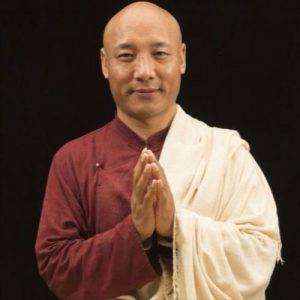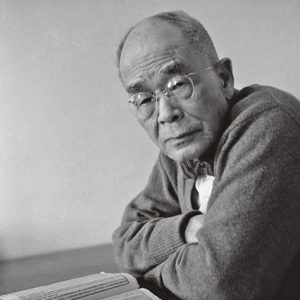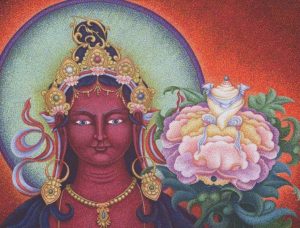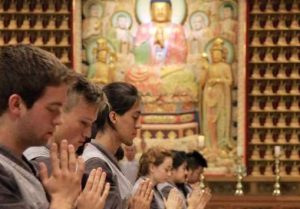
Among the variety of Buddhist lineages in the different regions of Asia, Tibetan Buddhism has perhaps the largest pantheon of well-respected female masters, who are revered at the highest level. One of them is Lady Yeshe Tsogyal (fl. eighth century). She is not a mysterious figure whose existence is subject to scholarly inquiry, rather she is a historical figure who plays an important role in Tibetan history as one of the first Tibetan Buddhist masters. Although there are other well-known female religious figures in Tibetan culture, she is perhaps the most revered among all of them. Today, in the Nyingma linage, Yeshe Tsogyal is loved along with Padmasambhava, with the understanding that both are equally enlightened.
The Tibetan king Songtsen Gampo founded the first Tibetan empire, the glory of which lasted centuries. Songtsen Gampo was a great military strategist and a skilled statesman, with a keen interest in culture and religion. He sent his minister, Thonmi Sambhota, to Nalanda University in India to study Buddhism and commanded him to develop a written Tibetan language so that the scriptures of the sutras and tantras could be translated into a native language. Songtsen Gampo also built temples, yet Buddhism could not take root in his land. A few generations after him, King Trisong Detsen invited from India the monk Shantarakshita, who ordained a group of Tibetans as monks. Trisong Detsen also built the first Buddhist monastery in Tibet, Samye Mighur Lhundrub Tsula Khang. At the suggestion of Shantarakshita, the king invited Padmasambhava to Tibet to teach the Dharma, especially the Vajrayana and Dzogchen practices. Among Padmasambhava’s Tibetan followers, 25 became his chief disciples. One of them, Yeshe Tsogyal, became his main disciple and her spiritual attainment is considered equal to his.
Yeshe Tsogyal was born in central Tibet to a clan known as Karchen. Today, her birthplace is called Tsogyal Latso and is regarded as a sacred site, kept alive by a small nunnery there.* She was married to the king, which would have been quite an ideal situation for many women in those days. At some point, she gave up her attachment to the royal lifestyle as well as all worldly riches, as they could not fulfill the higher meaning of life. She decided not to continue as queen and instead undertook the spiritual path with her whole heart. She mainly studied and practiced the Dharma under the guidance of Padmasambhava. During her life, she became a yogi who achieved a higher level of inner awakening, or bhumi, and gave tantric teachings to others, some of whom became well-known masters in their own right. In short, she was an accomplished tantrika and an enlightened Dzogchen master who was awakened to the ultimate truth.
Many centuries after her death, people’s devotion toward her has not waned but has grown ever stronger. Many books and liturgies have been written about her. She even appears as a central figure of the Yumka Sadhana by Jigme Lingpa. In this sadhana, she appears in the form of Vajrayogini, who is the embodiment of the three kayas, the expression of the tantric notion of enlightenment called empty-bliss awareness. This sadhana is performed on the 25th day of every lunar month in Nyingma monasteries. Many yogis practice it as their main personal sadhana.
Prominent scholars such as Jamgon Kongtrul and Lama Mipham have written hymns to Yeshe Tsogyal, in which she is described as an extraordinary enlightened being. There are profound teachings attributed to her that appear in terma, or treasure revelations, a class of writing that is considered to come from the author’s exalted state of consciousness that taps into the realm of the buddha-mind, visions, spontaneous revelations, or even other dimensions of reality.
There are different visionary biographies of Yeshe Tsogyal. Although they might tell different accounts of her life, they all capture the very essence of her being: courageous, intelligent, and compassionate. They deliver a powerful narrative that describes her as not only a spiritual figure but also the ideal of a noble human being, one whom we all would wish to emulate, regardless of whether or not we are spiritual. We human beings need ideals to bring out our best, and Yeshe Tsogyal is a powerful example. Connecting with her life serves as a means to invoke the noble attributes that lie at the very core of our being. The following verse from Lama Mipham’s prayer to her illuminates the heartfelt connection between her and the people of Tibet:
The mother of all the Buddhas, Vajrayogini;
Queen of the ocean of melodies, Saraswati;
The liberator of all beings with compassion,
Arya Tara; The Dakini who is kind to Tibet . . .
These words demonstrate that the Tibetan people regard her, along with Padmasambhava, as truly kind to Tibet. Such gratitude is expressed over and over in liturgies and prayers—a sentiment to which non-Tibetans might find it difficult to relate. Such a phenomenon is not abstract but is real and alive in the hearts of many Tibetans, who feel that Buddhism is a precious tradition, a most cherished treasure, that allows them to find the meaning of life and the path to inner freedom. Padmasambhava and Yeshe Tsogyal are both instrumental in their land, and stories say that they both are deeply concerned about the well-being of the Tibetan people.
In hindsight, Yeshe Tsogyal’s life is a testimony to the important role that women played in establishing Buddhism in Tibet, and to the doctrine of Vajrayana, which transcends the sexism that lurks in many religions around the world. It is inspiring to see so many revered female figures in Tibetan Buddhism, starting with Yeshe Tsogyal. Her life has been and will continue to be a reminder that all genders possess equal divinity and that we all have the same capacity to attain enlightenment.
* The Reawakening of Tsogyal Latso: Birthplace of Yeshe Tsogyal—a Generation Reborn (Buddhistdoor Global)
See more
Related features from Buddhistdoor Global
Lama Palden Drolma: Transmitting the Teachings to the West
The Siikainen Stupa: The Northernmost Stupa in the World
Life in the Red – The Long Journey to Really Being Daughters of the Buddha
Art as Buddhist Practice—A Portrait of Tsunma Jamyang Donma













